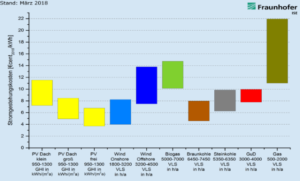Background
There is a global consensus that measures should be taken to control greenhouse gas emissions, which is called decarbonization of energy, so that the global temperature rise is less than 2º C, to avoid climate change. A reduction in energy related carbon dioxide emissions (CO₂) of almost 70% with respect to 2015 levels is required to ensure that this temperature level is not exceeded. It has been recognised by many Governments and organizations that it is necessary to invest heavily in innovation to achieve a transition to global low-carbon energy systems by the year 2050.
A recent analysis by IRENA shows that energy efficiency and renewable energy have the potential to achieve 90% of the emission reductions required by the year 2050, with the objective that renewables represent 67% of the primary energy supply in 2050, growing from 18% today. To meet the above objectives, the annual growth of the renewable share in total final energy consumption needs to be approximately 1.2% by 2050.
Challenge description
One of the most important challenges of the planet is climate change, due to the emission into the atmosphere of greenhouse gases, such as CO2, so it is necessary to develop technologies that reduce the carbon footprint in all activities.
All the industrial installations need energy in their production processes, in addition many sectors are intensive in energy consumption, contributing to the increase of greenhouse gases, Table 1.
Mitigating climate change, reducing CO2 emissions, is not an easy task, requiring an innovative effort in technology, improvements in existing systems (efficiency), and new combinations with other energy sources, which reduce the footprint of carbon and allow the activity to continue, generating benefits.

The fundamental criteria, in the past, for the generation of energy, both electric and thermal, in the industry were:
- Uninterrupted and reliable power availability.
- At competitive cost.
However, it is becoming increasingly common that environmental issues are taken into account within industry priorities and are present in the strategic agenda of corporations, mainly for the following aspects:
- Need to reduce emissions to avoid global warming.
- Environmental regulations and policies regarding emissions are increasingly demanding.
- The cost of CO2 emission rights is increasing and is expected to continue to do so in the future.
The rapid curve of experience in the development and use of renewable energies, mainly solar and wind, is converting this form of generation into an efficient and competitive alternative to traditional forms of energy generation based on fossil fuels.
What shows that the second criterion quoted above is being answered, however, for the moment, renewable generation systems are not manageable, given their intermittent character, so until there are no available technologies of reliable and competitive energy storage, the first criterion quoted at the beginning cannot be fully answered.

The need to respond to environmental challenges, together with the intermittent generation of renewable generating systems, are driving the use of mainly solar and wind power generation technologies, which are increasingly efficient, but with backup systems, either electrical/thermal energy storage or gas in combined cycles.
The partial substitution of fossil energy by renewable in the industry is a feasible and achievable objective, but in each case it is necessary to assess in addition to the profitability of the investment, the reduction of the CO2 emissions with its associated economic impact[1], and possible incentives of State or Local institutions, which with their policies favor the deployment of renewable technologies, as well as the impact on corporate social responsibility of companies.
Therefore, the availability of more efficient and competitive technologies for the generation of electric and thermal energy, without emissions that provide also efficient storage solutions, would have an extraordinary positive impact on the reduction of greenhouse emissions and on the sustainability of the planet.
[1] The price of CO2 until December 2017 has been less than €8/t, but in 2018 has risen to 20 €/t and is expected to continue to increase.
What is looking for?
Any type of electrical and/or thermal energy generation technology, without emissions, that allows in an efficient, competitive and continuous way to replace the technologies currently used to meet the industrial energy needs.
The key criteria for evaluating potential solutions to the proposed challenge are:
- Maximum substitution of fossil fuels by alternative energies with no CO2 emissions (“Zero-emission”).
- Maximum reduction of CO2 emission, thanks to longer time generation capacity (increased manageability).
- Competitive generation cost with conventional technologies. Low CAPEX and OPEX.
- Efficient and competitive support technologies to make renewable generation manageable through electrical and/or thermal storage systems.
- Minimum environmental impact.




